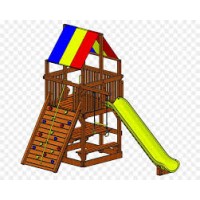Is A Wooden Playground Structure Safe?

-
Wood must not be treated or coated with toxic chemicals such as CCA or creosote.
-
Wood treated with newer, alternative chemicals may not be compatible with equipment hardware.
-
Proper parts should be utilized that have been provided or recommended by the manufacturer.
-
Assembly instructions should be followed (yes, you should read them!).
-
Unit should be anchored to the ground as recommended by the manufacturer.
-
Surfacing should be installed under and around play equipment.
-
Untreated wood will deteriorate rapidly. As these products age, stability may become an issue.
-
Wood surfaces must be splinter free. Given that wood is a product of nature, this is nearly impossible to achieve, and becomes worse as wood ages.
-
The design of wooden structures often does not meet CPSC requirements for safety, with elevated play surfaces, nails and screws.
Source: 2.5 Equipment Materials
Public Playground Safety Handbook - CPSC Publication 325
U.S. Consumer Product Safety Commission
2.5.1 Durability and finish
• Use equipment that is manufactured and constructed only of materials that have a demonstrated record of durability in a playground or similar setting.
• Finishes, treatments, and preservatives should be selected carefully so that they do not present a health hazard to users.
2.5.4 Paints and finishes
• The manufacturer should ensure that the users cannot ingest, inhale, or absorb potentially hazardous amounts of preservative chemicals or other treatments applied to the equipment as a result of contact with playground equipment.
2.5.5 Wood
• Wood should be either naturally rot and insect resistant(e.g., cedar or redwood) or should be treated to avoid such deterioration.
• Creosote-treated wood (e.g., railroad ties, telephone poles, etc) and coatings that contain pesticides
should not beused.
2.5.5.1 Pressure-treated wood
A significant amount of older playground wood was pres-sure-treated with chemicals to prevent damage from insects and fungi. Chromated copper arsenate (CCA) was a chemical used for decades in structures (including playgrounds).Since December 31, 2003, CCA-treated wood is no longer processed for use in playground applications. Other rot and insect resistant pressure treatments are available that do not contain arsenic; however, when using any of the new treated wood products, be sure to use hardware that is compatible with the wood treatment chemicals. These chemicals are known to corrode certain materials faster than others.
Existing playgrounds with CCA-treated wood
Various groups have made suggestions concerning the application of surface coatings to CCA-treated wood (e.g., stains and sealants) to reduce a child’s potential exposure to arsenic from the wood surface. Data from CPSC staff and EPA studies suggest that regular (at least once a year) use of an oil or water based, penetrating sealant or stain can reduce arsenic migration from CCA-treated wood. Installers, builders, and consumers who perform woodworking operations, such as sanding, sawing, or sawdust disposal, on pressure-treated wood should read the consumer information sheet available at the point of sale. This sheet contains important health precautions and disposal information.
When selecting wood products and finishes for public play-grounds, CPSC staff recommends:
• Avoid “film-forming” or non-penetrating stains (latex semi-transparent, latex opaque and oil-based opaque stains) on outdoor surfaces because peeling and flaking may occur later, which will ultimately have an impact on durability as well as exposure to the preservatives in the wood.
• Creosote, pentachlorophenol, and tributyl tin oxide are too toxic or irritating and should not be used as preservatives for playground equipment wood.
• Pesticide-containing finishes should not be used.
• CCA-treated wood should not be used as playground mulch.
Copyright 2013 DunRite Playgrounds
